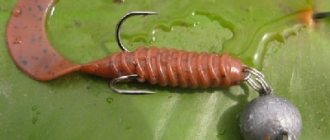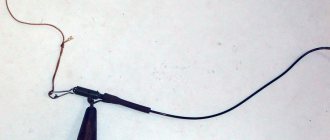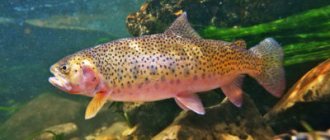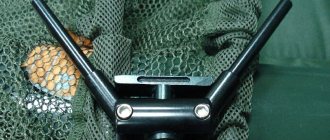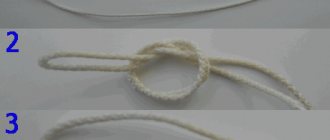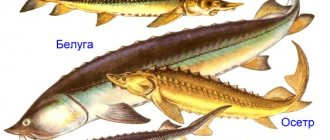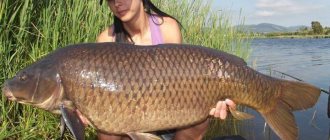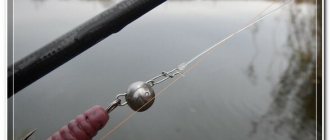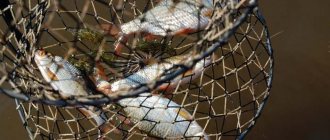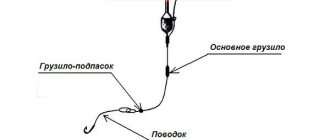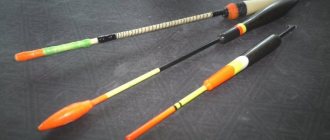Not a single spinning rod can do without a leash when catching a predator.
Some use fluorocarbon leashes, believing that the main thing is the invisibility of the equipment, others use metal ones, believing that its invisibility in the water is not so important and vote for durability. One thing remains the same: choosing a leash is the key to successful fishing! The article provides an overview of leash materials, their positive and negative properties, discusses the types of leashes, describes the installation and methods of making a leash at home, and useful videos will help you apply this element of equipment in practice.
Content
- 1. What is a fishing leash
- 2. What is a leash for?
- 3. Main characteristics of the leash
- 4. Where are leashes used?
- 5. What gear are the leashes attached to?
- 6. Material from which leashes are made
- 6.1 Fluorocarbon leaders
- 6.2 Leaders made of leader material
- 6.3 Steel leads
- 6.4 Titanium leads
- 6.5 Tungsten leaders
- 6.6 Guitar string leads
- 7.1 Neutral leashes
- 7.2 Sinking leads
- 7.3 Pop-up leashes
- 7.4 Invisible leashes
- 7.5 Hard leashes
- 7.6 Combined leashes
Installation methods
The important point is to attach it to the fishing line. There are several ways to do this. You can use different nodes or use other connection methods.
Loop-to-loop installation
One of the simplest ways. In a sense, it can't even be called a node. How to carry out the installation can be seen from the figure.
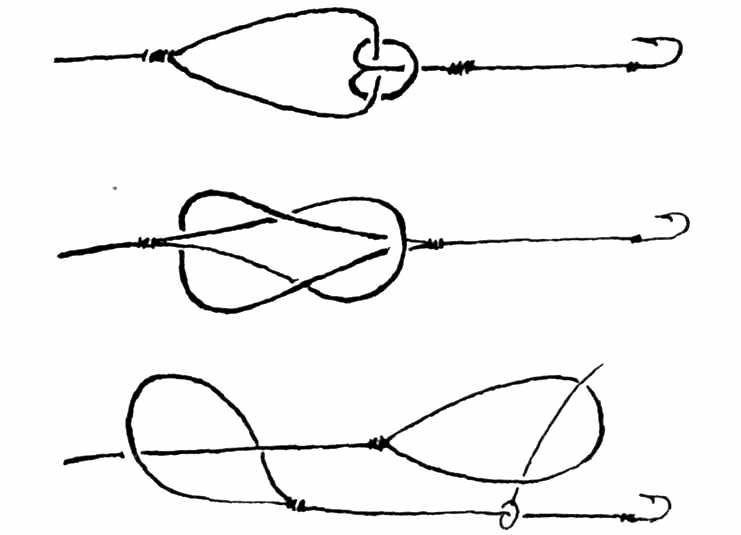
Installation "running unit"
This knot can be tied quite simply.

Using the figure eight knot
This type of connection has a number of advantages:
- This node does not move when pressure is applied to it.
- Loops that were tied in this way do not tighten.
- It is very easy to connect; it only takes a few seconds.
Note that the second row shows how to use this knot to tie a fishing line and a leash.

Using the Palomar node
The figure shows how to work with this node.
This knot is used for tying a fishing hook, bait and in other similar cases.
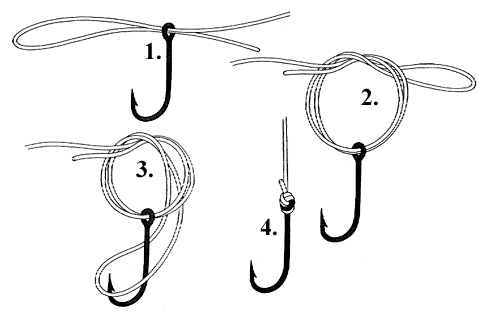
What is a leash for?
Purpose of the leash:
- Protection of the rod rig from unexpected snags and breaks, biting of the fishing line by a predator, wear and tear, as this factor is influenced by the number of casts, and friction of the fishing line against underwater obstacles in the form of stones, reefs, and algae.
- Inconspicuous in the water, since the color of the leader is used to match the color of the water, and it has a smaller diameter than the main line.
- The small diameter (thinness) allows the bait to be more mobile and behave naturally in the water, which attracts prey.
- The bait attached to the leash naturally plays in the water.
- Allows you to quickly change the hook.
How to make
The process of making a leash with your own hands is as follows:
- A piece of fishing line of the required length is cut.
- A loop is made at one end of the fishing line. The simplest and most reliable is the double surgical knot.
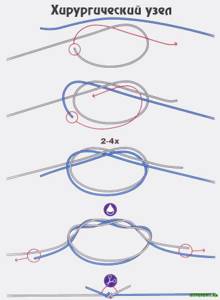
Make a loop, then make two turns with the folded fishing line.
- A hook is attached to the other end of the fishing line.
- to tie a hook with an eye, the fishing line is first passed into the eye, then a loop is formed from the fishing line parallel to the shank of the hook, the free end of the fishing line is made 5 turns around the loop, passed into the loop and the knot is tightened, having previously moistened it with water or saliva;
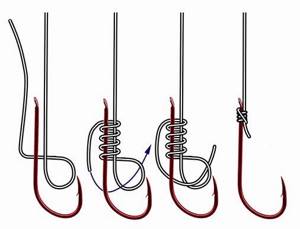
a hook with a spatula is tied in the same way, only more turns of the end of the fishing line around the loop are made - 8-10.
Main characteristics of the leash
Breaking load - this characteristic is reflected on the packaging; if the leash is made independently, then the load is determined through experiments.
The flexibility of the leader affects the performance of the bait, especially when small baits are used. For using large baits, this indicator is not important.
Wide range of colors - taken into account when choosing a reservoir.
Diameter – affects the breaking load of the leader. So, the higher this indicator, the worse the performance of the bait; the lower, the greater the probability of rupture. This characteristic is selected individually and depends on the size of future production and the characteristics of the reservoir.
It is important to remember that the selection of the diameter of the leader material must be combined with the hook.
Conventional combination of hook and leash diameter:
- No. 20 – 0.08 mm;
- No. 18 – 0.1 mm;
- No. 16 – 0.12 mm;
- No. 14 – 0.14 mm;
- No. 12 – 0.16 mm;
- No. 10 – 0.18 mm.
For example, for plug-in float and fly tackle, the difference between the diameter of the main line and the diameter of the leash should be 0.02 mm with a blind installation method. When using a fly rod, the main line is 0.2 mm, and the leader is 0.1 mm. When using reel rods, this difference can be greater.
The length of the leash plays a role:
- when casting bait over a long distance;
- on the size of future production;
- feeding fish (in case of carp fishing).
What should be the length of the leash for float tackle:
- lap dog - from 2.5 cm to 45.5 cm;
- match rod - from 2.5 cm to 45.5 cm;
- for catching small fish, from 8.5 to 10 cm is suitable.
- cord or fishing line (base);
- loops;
- crimp tubes;
- carabiner (attached to the main fishing line);
- swivel, used for free rotation of the bait that is attached to it.
Accessories for the leash:
Leash elements
It consists of two required elements: a fishing line and a hook. In some cases, an additional sinker is attached to the leash.
fishing line
The leash line performs the following functions:
- serves as a link between the main line and the hook with bait;
- used for tying a hook;
- acts as a shock absorber when landing fish.
It is customary to use monofilament or fluorocarbon as fishing line for the leash. Monofilament has the following advantages:
- relative invisibility in water;
- high knot strength;
- low price.
Fluorocarbon is practically invisible in water and has no memory , and is also durable because it is resistant to aggressive environmental factors. But its low elongation, which is very valuable in spinning, is rather harmful in float equipment, since the thin line of the leash should soften the jerks of the fish. Fluorocarbon has lower knot strength than monofilament. Additionally, fluorocarbon is quite expensive.
Expert opinion
Knipovich Nikolai Mikhailovich
Zoologist, hydrobiologist. I am interested in fishing at a professional level.
Important! The line for leashes should be chosen carefully. It is necessary to check how much the actual breaking load of the fishing line corresponds to the declared one, how the fishing line holds the knots and look at its shelf life.
In any case, the fishing line for the leash must be of high quality; it is advisable to purchase fishing line from trusted manufacturers.
Hook
The hook must also be of high quality. Its size is determined not by the size of the expected catch, as is commonly thought, but by the size of the bait. For fishing with a float, hooks with an eye and a spatula are used.
What gear are leashes attached to?
- spinning;
- fly rod;
- match rod;
- balonese;
- float tackle;
- fly rod;
- girder;
- mugs.
Under what circumstances is it appropriate to use them? Firstly, when fishing in an area without algae or when catching cautious fish - for the sensitivity of the bite and the invisibility of the gear. Secondly, when catching medium-sized fish and when the bite is sluggish, it is more convenient to hook with thinner equipment. Thirdly, to avoid breaks in the main line in rocky and vegetative areas.
For fans of feeder fishing, it will be interesting to read an article from the magazine “Sports Fishing” entitled “Classic and modern English donka. Feeder leash assembly" https://sfish.ru/page/klassicheskaja-i-sovremennaja-anglijskaja-donka-fidernyj-povodok-v-sbore
For fans of sea fly fishing, the article “With fly fishing in the Black Sea” (magazine “Sports Fishing” https://sfish.ru/page/s-nahlystom-v-chernom-more) will be of interest
Material from which leashes are made
The presented classification of leader material will help influence the quality of bites. The advantages and disadvantages of various types of this part of the equipment will be discussed further.
Rating of leashes by price (from expensive to cheap leashes):
- Titanium leashes
- Tungsten
- Steel (strings)
- Braided steel
- Fluorocarbon
- Nylon
6.1 Fluorocarbon leaders
The combination of fluorine and carbon allows one to obtain a substance such as fluorocarbon. The technical side of fluorocarbon production is identical to the production of nylon monofilament lines.
Leaders made of this material are recommended for use in cases where camouflage of the fishing line in the water plays an important role, for example, when catching cautious fish. Fluorocarbon is valued for its transparency in water, however, not 100%.
The downside to using fluorocarbon wire is that the larger the diameter, the more noticeable it is in the water. Thus, a leash diameter greater than 0.35 mm already loses its “invisible” properties.
Positive properties:
- invisibility in water due to the low level of light refraction in water;
- wear resistance, does not stretch, which allows for sharp and powerful hooking of fish;
- speed of immersion in water;
- the ability to withstand changes in temperature conditions, which does not affect the loss of its original characteristics;
- does not absorb water, which allows it to retain its shape for a long time.
What kind of gear is a fluorocarbon leash attached to:
- spinning rod (lead length from 1 to 3 m);
- float rod (lead length from 15 to 30 cm);
- feeder (used less often, since the equipment lies on the bottom when casting, but with some equipment options, a leash can be attached and then the equipment will hang in the water column above the bottom).
The diameter of the leader depending on the weight of the fish:
- from 1.3 kg – not less than 0.14 mm;
- from 1.8 kg – 0.16 mm;
- from 4 kg – 0.2 mm;
- from 6 kg - 0.31 mm.
An interesting video about this type of leash from the “Hunter and Fisherman” channel
6.2 Leaders made of leader material
Leashes made from leash material are homemade. This material is purchased in a store and consists of many thin steel rods, which are woven together into one thread and covered with a special film. Then leashes are made from it.
Area of application : fishing with spinners and wobblers in areas overgrown with vegetation. For example, Russian fishermen use this material to make leashes for pike fishing. Under such fishing conditions, fluorocarbon leashes should not be used due to their high cost and the high probability of being eaten by a predator.
Fishing methods:
- jig;
- mugs.
Advantages of this material:
- softness, which has a positive effect on the performance of light-weight baits;
- low memory, which eliminates severe deformation of the leash over time.
Flaws:
- wears out, which manifests itself in the form of detachment of threads of material from the common braid, in which case the leash needs to be replaced;
- with strong knots it becomes deformed.
Instructions for making a leash from leash material are described in detail here https://makchen.ru/nadezhnye-povodki-dlya-rybalki-svoimi-rukami-iz-povodkovogo-materiala-pontoon-21.html
Interesting to see! A little trick for squeezing a leash at home from the author of the video 100500 obzorov
6.3 Steel leads
Advantages of a steel leash:
- rigidity (impossibility of snacking on fish);
- does not get confused;
- passes through algae perfectly and cuts them with a sharp jerk;
- attractive price.
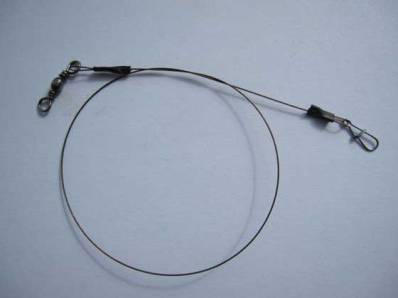
Flaws:
- cumbersome equipment;
- poor camouflage in water;
- nodes are the weakest point;
- plastic.
Application area:
- jig fishing;
- twitching;
- fishing with wobblers.
Where to buy:
- fishing shops;
- make it yourself from pieces of field wire (other names: field wire, military field cable) or guitar string (the largest in diameter).
One example of making a leash from bentgrass, proposed by the author-fisherman Corleone
Advantages of a field cable leash:
- ease;
- small diameter;
- cheap;
- excellent for fishing with small wobblers (does not affect their behavior in water).
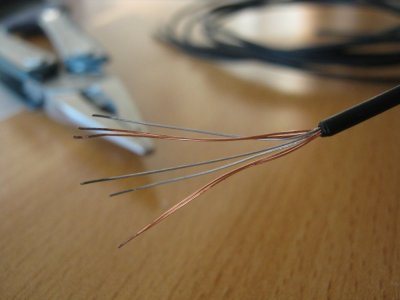
Advice: when using wobblers, to prevent their loss, it is better to attach such a leash to the factory ring of the bait.
Flaws:
- poor flexibility and not long (no more than 15 cm), if you do more, the leash will begin to curl;
- When fishing for large fish, the loop of such a leash becomes very tight.
- does not have an even shape, you need to manually align it;
- production time costs.
6.4 Titanium leads
Titanium leashes are one of the most modern elements of spinning equipment on the fishing market and differ from the rest in their high cost.
Externally very similar to leashes made of leash material.
Advantages:
- durability;
- zero memory;
- resistance to snacking;
- It is made of lightweight material, which allows the wobbler to show all its playing properties in the water. For example, metal leashes can make any surface wobbler suspended or sinking due to the heavy weight of the equipment;
- do not require special care, as they are not subject to oxidation.
Flaws:
- rude;
- noticeable in the water;
- subject to rupture, for example, when caught on snags;
- the high cost of the leash and accessories for it.
Twenty-minute video from V. Kolomiets, offering one of the methods for making a leash from titanium material
6.5 Tungsten leaders
The leash is made by twisting threads of tungsten material.
Tungsten is the most refractory metal. In the USA, France and England, such material is usually called “tungsten” or in Russian heavy stone.
Advantages:
- inexpensive;
- soft, which has a good effect on the game of the bait;
- reliable.
Tip: to extend the life of the leash and straighten it, just hold the bend over the fire (for example, using a lighter). However, it is worth remembering that when using this method of resuscitation, the leash at the warming site becomes brittle.
Flaws:
- short-lived (when used more than three times, it tends to twist strongly, which makes it completely unusable for further use);
- quickly wears out in the place where the fastener is attached, which may be a consequence of losing the wobbler.
6.6 Guitar string leads
To make a leash at home, you need to twist two guitar strings (1 and 2) together.
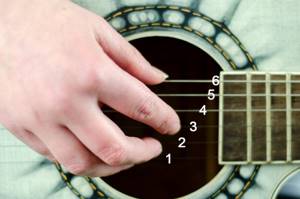
Advantage:
- no need to use additional fittings, since loops are made at the ends of the future leash;
- strength;
- rigidity.
Flaws:
- poor flexibility, which ultimately has a bad effect on the performance of the bait;
- inconvenience when attaching or removing the bait (you need to unwind the loops);
- are susceptible to corrosion, even in freshwater, so use in sea fishing is not advisable.
What parameters must it meet?
The main parameters of the leash are determined by the following characteristics of the fishing line:
- Breaking load. The breaking load of the leader should always be lower than that of the main line.
- Color. Most anglers use clear line to make leaders because it is the most versatile. But there are those who pay special attention to the color of the fishing line. In such a case, there are the following recommendations:
- very clear water - blue line;
- fishing in the grass - green line;
- fishing on a sandy bottom - yellow line;
- fishing on a pebble bottom - brown line;
- fishing in snags - black line.
- Length. The length of the leash is a very important parameter, which depends on the type of equipment and the fish that is the intended prey.
- for a fly fishing rod – 15-20 centimeters;
- for a plug fishing rod – 10-15 centimeters;
- for match and Bologna rigs - 25-30 centimeters.
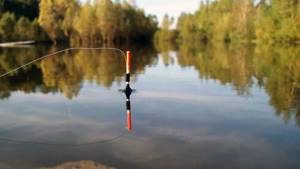
Depending on the type of equipment, the length of the leash varies within the following limits:
Depending on the type of fish, the length of the leash is:
- For bleak. A leash 10-15 cm long is quite sufficient, since fishing is carried out in the middle or surface layers of water.
- For roach. Depending on the type of equipment, the length of the leash varies from 15 to 30 centimeters.
- For bream. Bream need a long leader. If you have to fish in the bottom layer, the leash should be 25-30 centimeters long. Bream are often caught using bait lying motionless on the bottom. In such cases, a small pellet is installed in front of the hook at a distance of 5-10 centimeters, performing the function of a feeder. Having taken the bait in its mouth, the bream does not feel resistance, while the float rises and lies on its side, giving the angler a signal of a bite.
Expert opinion
Knipovich Nikolai Mikhailovich
Zoologist, hydrobiologist. I am interested in fishing at a professional level.
Attention! Monofilament fishing lines can be soft or hard. Rigid fishing line is more suitable for making leashes because it tangles less.
Separately, it is worth mentioning leashes for catching predatory fish using float rigs. To catch perch with fry, fluorocarbon leashes with a single hook are used. To catch pike with live bait, use metal leashes made of soft leash material or thick fluorocarbon leashes. Hooks can be single, double or triple, depending on the fishing conditions.
Hooks for leashes should also be given close attention. Depending on the type of bait, hooks can be of different sizes, made of wire of different thicknesses, have a short or long shank, etc. You can also find hooks of a specific shape, for example, carp hooks and red hooks. Hooks are produced with notches on the shank, designed to prevent the worm from slipping off the hook when casting and during fishing.
Types of leashes
7.1 Neutral leashes
Neutral - made of soft woven materials.
Peculiarity:
- do not float up;
- don't drown.
Why? Because the density of the leash is equal to the density of water. Mainly used in algal areas of the reservoir.
For example, these leashes:
- super nova kryston;
- magician suffix.
Advice:
- such leashes can become sinking due to rubbing with soft lead;
- with a neutral leash, it is better to use bottom baits or baits of neutral buoyancy.
7.2 Sinking leads
Such leashes lie on the bottom. Used in places where the bottom is clean.
The disadvantage is that the diameter is thicker than other leashes.
Manufacturers of sinking leashes:
- delude fox;
- Merlin Kriston;
- nuflex sufix.
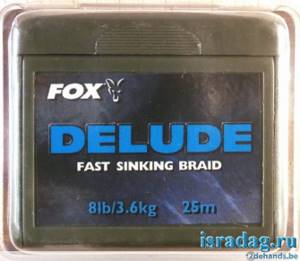
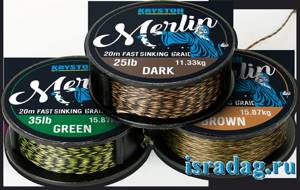
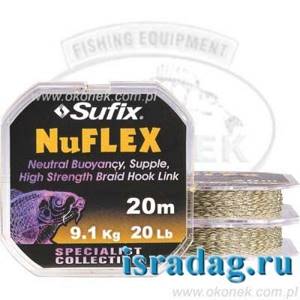
7.3 Pop-up leashes
They are used in overgrown areas and with a thin muddy layer of the bottom. For example, such leashes are used when fishing for carp. The leashes are made in such a way that it is possible to “hang” the leash above the bottom surface in a suspended state. An example of such leashes are leashes made of polyethylene.
7.4 Invisible leashes
Used in clear water and on a clean bottom.
7.5 Hard leashes
Such leashes are used for fishing with jerk baits and jig baits. When using a 12-15 cm bait, a leash with a diameter of 0.3-0.5 mm and a length 1.5 times longer than the bait itself is used. This indicator is the most optimal. For example, when using a 0.45 mm leader and a 2.5 cm bait, the jerk will sink.
Advantages:
- affordable price;
- the ability to choose the optimal leash for the bait used;
- an alternative to invisible leashes when the fish gets tired of them.
Flaws:
- increased ability to deform;
- fragility, as they are highly susceptible to rust.
7.6 Combined leashes
Such leashes are made from leashes of various types. For example, an invisible leash can be paired with a sinking one; this combination is advantageous in that one part of the leash is at the bottom, and the second invisible one floats up. Where to apply this combination? For example, when hunting cautious fish, or as a surprise-new item for fish. An option with a combination of materials is possible - braided and fluorocarbon.
Advantages:
- new for fish;
- designed for various baits;
- maximum camouflage.
How to make a dog leash with your own hands
A dog leash, especially the first one for a puppy, can be made on your own. There are several options. Let's look at the simplest method using the most accessible materials.
You will need:
- braid made of cotton or nylon fabric;
- ribbon made of decorative material;
- soft flannel for the inside;
- industrial small but durable carabiner;
- strong, preferably lavsan, threads.
The manufacturing scheme is as follows:
- The braid, flannel and ribbon are basted together. This will make the accessory attractive.
- The edge of the sling is bent to secure the carabiner.
- The connection must be sewn several times on a sewing machine to ensure that the carabiner is securely fastened.
- At the opposite end of the sling, form a loop for the hand and also stitch the junction.
Two options for how you can make a dog leash with your own hands:
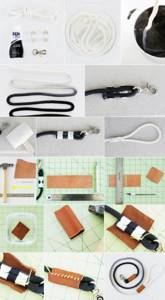
How and where to store leashes
Possible storage locations:
- A photo album with “pockets”, where information about the size, diameter, etc. is written on the pocket with a marker.
- A heat-insulating tube, onto which leashes are attached along the entire length from the outside, by fastening the loop of the leash with a pin, and the hook on the other side is stuck into the tube. Minus: the leads are located outside and are not protected by anything; the tube may become deformed during transportation. Plus: cheap storage method.
- Leash holders (made of plastic or wood).
- You can buy a set of cheap paralon reels.
Storage rules:
- It is better to organize leashes according to characteristics.
- Store in such a way as not to deform them.
- Store in a dry place.
Rules of care:
- Store in paper soaked in machine oil to avoid rust.
- Lubricate with Vaseline or machine oil.
Option for making a leash at home from OSD2006
Is it required?
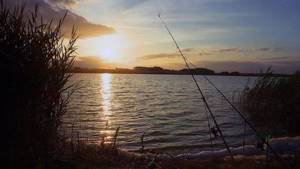
Today it is difficult to imagine float equipment without a leash. The leash will save the entire equipment in case of a blind hook , or if a fish of an unexpected size bites. The long leash that the Bolognese fishing rod is equipped with allows the hook and bait to play in the current. A long leash with a sinker used when fishing for bream is designed so that the fish, when taking the bait in its mouth, does not feel any resistance.
useful links
https://ulov.guru/snasti/spinning/flyurokarbonovyy-povodok-ego-osobennosti-i-sposoby-primeneniya.html - article about fluorocarbon leash, its features and application;
https://handf.mirtesen.ru/blog/43475273987/Povodki-dlya-spinninga - article about leashes for spinning rods;
https://www.my-spinning.com/povodki/povodok-iz-polevogo-kabelya.html - article about leashes made from field cable;
https://fishingwiki.ru/Leash - information about leashes from Wikipedia;
https://plotka.ru/lovlya-na-otvodnoy-povodok/ — an interesting article about the features of fishing with a retractable leash.
